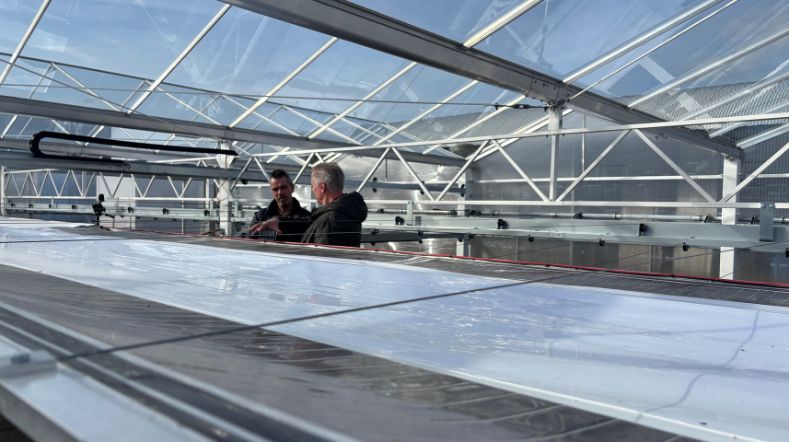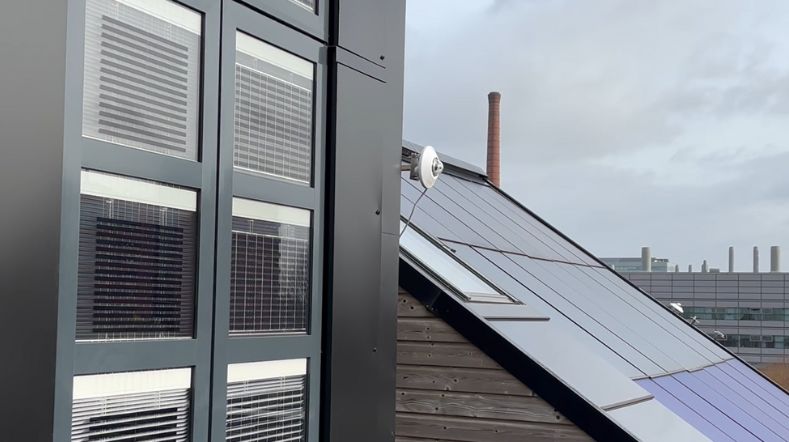
Solar panels on infrastucture
Installing solar panels in and around the road surface allows for the large-scale generation of solar energy without the need for additional space. This gives existing surfaces such as roads, roadsides, noise barriers, crash barriers, and bicycle paths a new function as a source of renewable energy.
Solar panels in noise barriers
We have now created a design that works optimally as a sound-damping barrier and energy source. Solar Highways is a noise barrier along the motorway measuring 400 metres long and 5 metres high. It incorporates 1,600 square metres of solar cells on both sides (bifacial PV), which convert sunlight into electricity. We developed this on behalf of and together with Rijkswaterstaat. Heijmans Infra built the barrier.
Collaboration with industry
The Solar Highways project is an example of the successful cooperation between government, knowledge institutions, and industry. We developed the prototype solar panels in the barrier and connected research to practice.
New method for collecting sunlight
This project also used the method in which sunlight is captured at the back of solar cells and is converted into electricity. Combined with vertical placement, this opens up many new possibilities. Not only for noise barriers but also for solar panels in combination with crop cultivation or vegetation. Because the panels take up very little space in this position, other activities remain possible.
Noise barriers along the tracks
In addition to roadside noise barriers, we are also testing solar panels on noise barriers along railway tracks. In het NEWRAIL project, we are working with ProRail, which has 500 to 700 kilometres of noise barrier available. This could all potentially be used for renewable energy generation.
Solar panels on the crash barrier
The Netherlands has about 7,500 kilometres of crash barrier, which can be used to generate a lot of solar energy, via flexible solar foil on crash barriers (see image). We researched this together with the Province of North-Holland and various partners. The test setup on 72 metres of dual crash barriers was run along the N194 near Heerhugowaard for a year. The design is the first of its kind worldwide. The trial was completed and the setup continued to function well in various weather conditions. Costs now need to come down further to make it profitable and continued development of components is needed.
Development of PV on the guide rail
The road network in the Netherlands offers starting points for integrating PV that can convert even more sunlight into electricity.
Solar cells on roads
The Dutch road network is some 140 thousand kilometres long. Much of it is basically suitable for solar cell technology. TNO, with partners in the Solaroad project, conducted tests with solar cells in the road surface. The resulting Solaroad company was discontinued as commercial application has not yet proved feasible. The technical challenge is that roads are heavily loaded and to generate solar energy on them requires robust material. Further development of the existing technology, is needed.
Rolling Solar
In the Rolling Solar project, two stretches of road surface were fitted with solar cells. One with traditional crystalline silicon technology and the second based on thin film (CIGS). At the Brightlands Chemelot Campus, the project team started the construction of a SolaRoad surface based on crystalline silicon solar cells. It has been tested for temperature profiles, electricity production, and robustness.
Thin-film solar cells
A second pilot with a section of road with thin-film solar cells also took place. These solar cells are easier and cheaper to integrate into new prefab and existing road surfaces than traditional technology.
Final report Rolling Solar
Curious about the final results of the project?
Solar panels on dikes
In our country, about 1,600 kilometers of dike surface are in principle suitable for installing solar panels. But how does this affect the safety of the dikes? Does it fit visually with the landscape? And is the yield of sustainable energy worth the possible disadvantages? In cooperation with partners, TNO is researching the suitability of solar panels on dikes.
The final report Sun on Dikes shows that solar panels placed on a dike revetment are the most suitable and can be applied without much additional research. Systems in which the grass revetment of the dike is largely shaded by the solar panels are not suitable for the time being, because the quality of the grass quickly deteriorates.
Get inspired
Shade screens with rollable solar foil combines energy generation with climate control in greenhouses


Building fires with solar panels mapped for the first time


New multifunctional solar window generates energy by reflecting light


Webinar: Solar energy in Brabant - Building a sustainable future for Europe


Reduced energy yield due to rapid shading of solar panels by wind turbines





